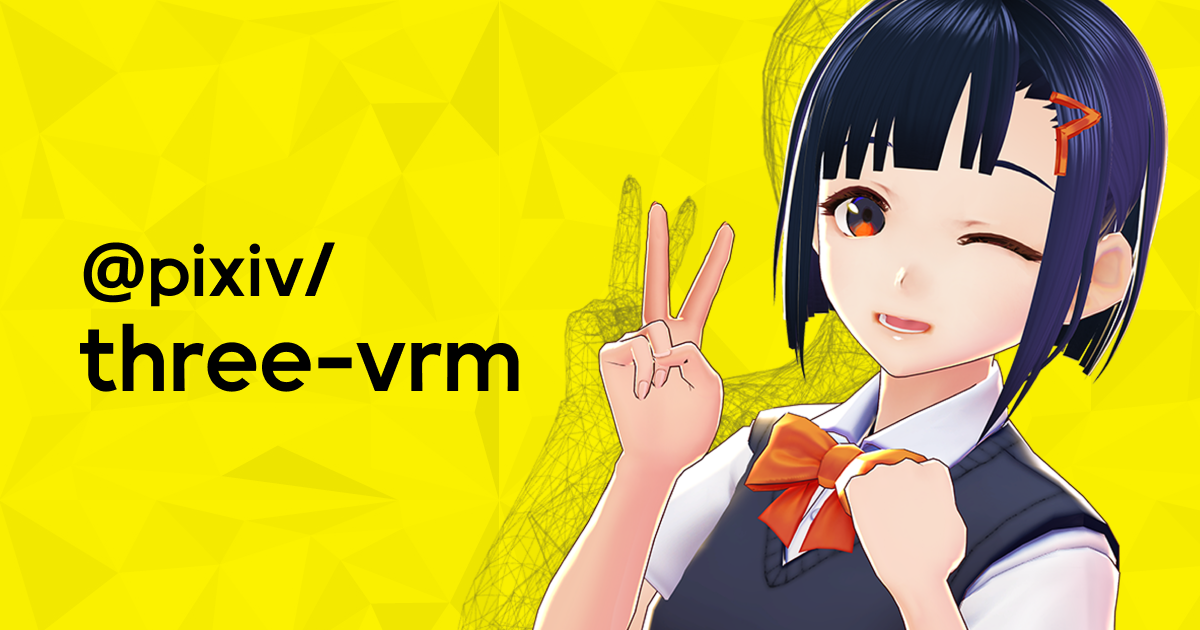@pixiv/three-vrmVerwenden Sie VRM auf drei.js

Github -Repository
Beispiele
Dokumentationen
API -Referenz
Sie brauchen:
.module sind ESM, ansonsten ist es UMD und injiziert seine Module in globale THREE.min werden abgebaut (für die Produktion), sonst wird es nicht abgebaut und es wird mit Quellkarten geliefertSie können alle Abhängigkeiten über CDN wie Jsdelivr importieren.
< script type =" importmap " >
{
"imports" : {
"three" : "https://cdn.jsdelivr.net/npm/[email protected]/build/three.module.js" ,
"three/addons/" : "https://cdn.jsdelivr.net/npm/[email protected]/examples/jsm/" ,
"@pixiv/three-vrm" : "https://cdn.jsdelivr.net/npm/@pixiv/three-vrm@3/lib/three-vrm.module.min.js"
}
}
</ script >
< script type =" module " >
import * as THREE from 'three' ;
import { GLTFLoader } from 'three/addons/loaders/GLTFLoader.js' ;
import { VRMLoaderPlugin } from '@pixiv/three-vrm' ;
// ... Setup renderer, camera, scene ...
// Create a GLTFLoader - The loader for loading VRM models
const loader = new GLTFLoader ( ) ;
// Install a GLTFLoader plugin that enables VRM support
loader . register ( ( parser ) => {
return new VRMLoaderPlugin ( parser ) ;
} ) ;
loader . load (
// URL of the VRM you want to load
'/models/VRM1_Constraint_Twist_Sample.vrm' ,
// called when the resource is loaded
( gltf ) => {
// retrieve a VRM instance from gltf
const vrm = gltf . userData . vrm ;
// add the loaded vrm to the scene
scene . add ( vrm . scene ) ;
// deal with vrm features
console . log ( vrm ) ;
} ,
// called while loading is progressing
( progress ) => console . log ( 'Loading model...' , 100.0 * ( progress . loaded / progress . total ) , '%' ) ,
// called when loading has errors
( error ) => console . error ( error ) ,
) ;
// ... Perform the render loop ...
</ script >Siehe das Dreier-Dokument, wenn Sie mit drei.js noch nicht vertraut sind: https://whreejs.org/docs/#Manual/en/inTroduction/creating-a-scene
Weitere Informationen finden Sie im vollständigen Code: https://github.com/pixiv/three-vrm/blob/release/packages/three-vrm/examples/basic.html
Installieren Sie three und @pixiv/three-vrm :
npm install three @pixiv/three-vrm Ab V3 bieten wir WebGpurenderer -Kompatibilität an. Um drei VRM mit WebGpurenderer zu verwenden, geben Sie die WebGPU-kompatible MToonNodeMaterial für die materialType Option MToonMaterialLoaderPlugin an.
MToonNodeMaterial unterstützt nur drei.Js R167 oder höher. Das nodematerialische System von drei.Js ist noch in der Entwicklung, sodass wir die Kompatibilität mit älteren Versionen von drei.
import { GLTFLoader } from 'three/addons/loaders/GLTFLoader.js' ;
import { MToonMaterialLoaderPlugin , VRMLoaderPlugin } from '@pixiv/three-vrm' ;
import { MToonNodeMaterial } from '@pixiv/three-vrm/nodes' ;
// ... Setup renderer, camera, scene ...
// Create a GLTFLoader
const loader = new GLTFLoader ( ) ;
// Register a VRMLoaderPlugin
loader . register ( ( parser ) => {
// create a WebGPU compatible MToonMaterialLoaderPlugin
const mtoonMaterialPlugin = new MToonMaterialLoaderPlugin ( parser , {
// set the material type to MToonNodeMaterial
materialType : MToonNodeMaterial ,
} ) ;
return new VRMLoaderPlugin ( parser , {
// Specify the MToonMaterialLoaderPlugin to use in the VRMLoaderPlugin instance
mtoonMaterialPlugin ,
} ) ;
} ) ;
// ... Load the VRM and perform the render loop ...Weitere Informationen finden Sie im vollständigen Code: https://github.com/pixiv/three-vrm/blob/release/packages/three-vrm/examples/webgpu-dnd.html
Siehe: beitragen.md
MIT